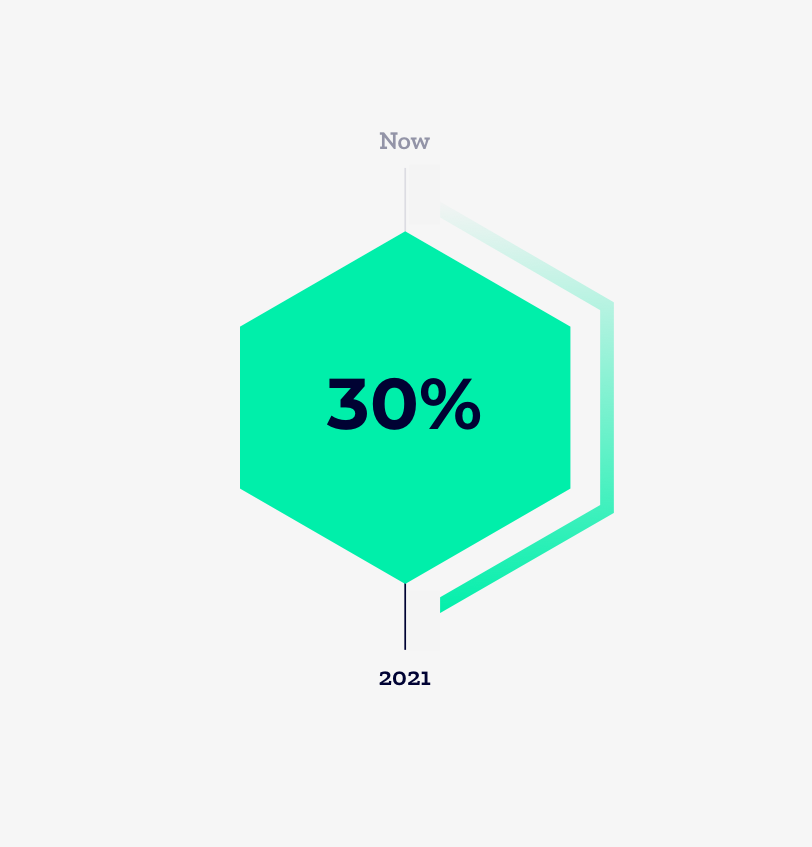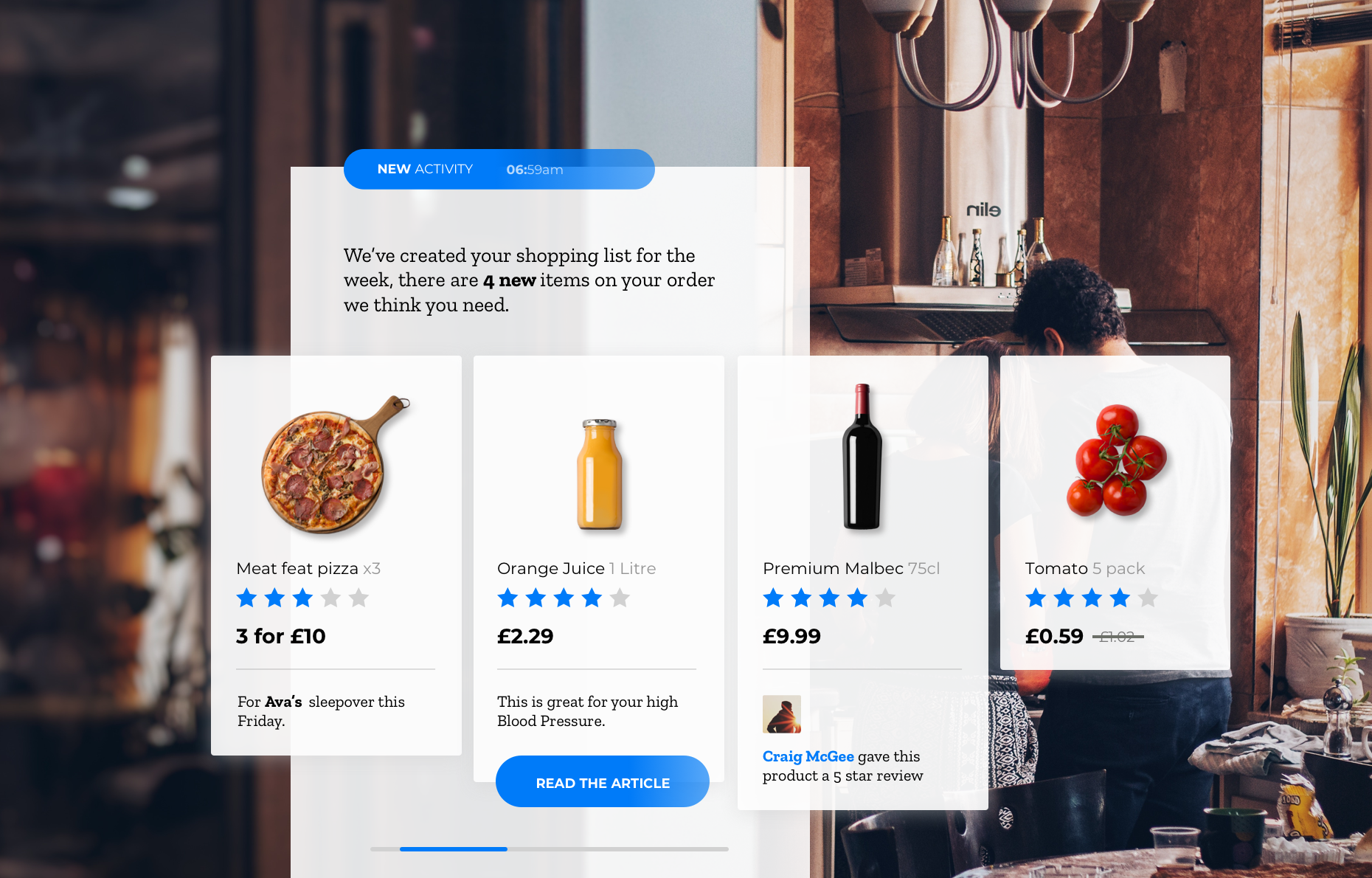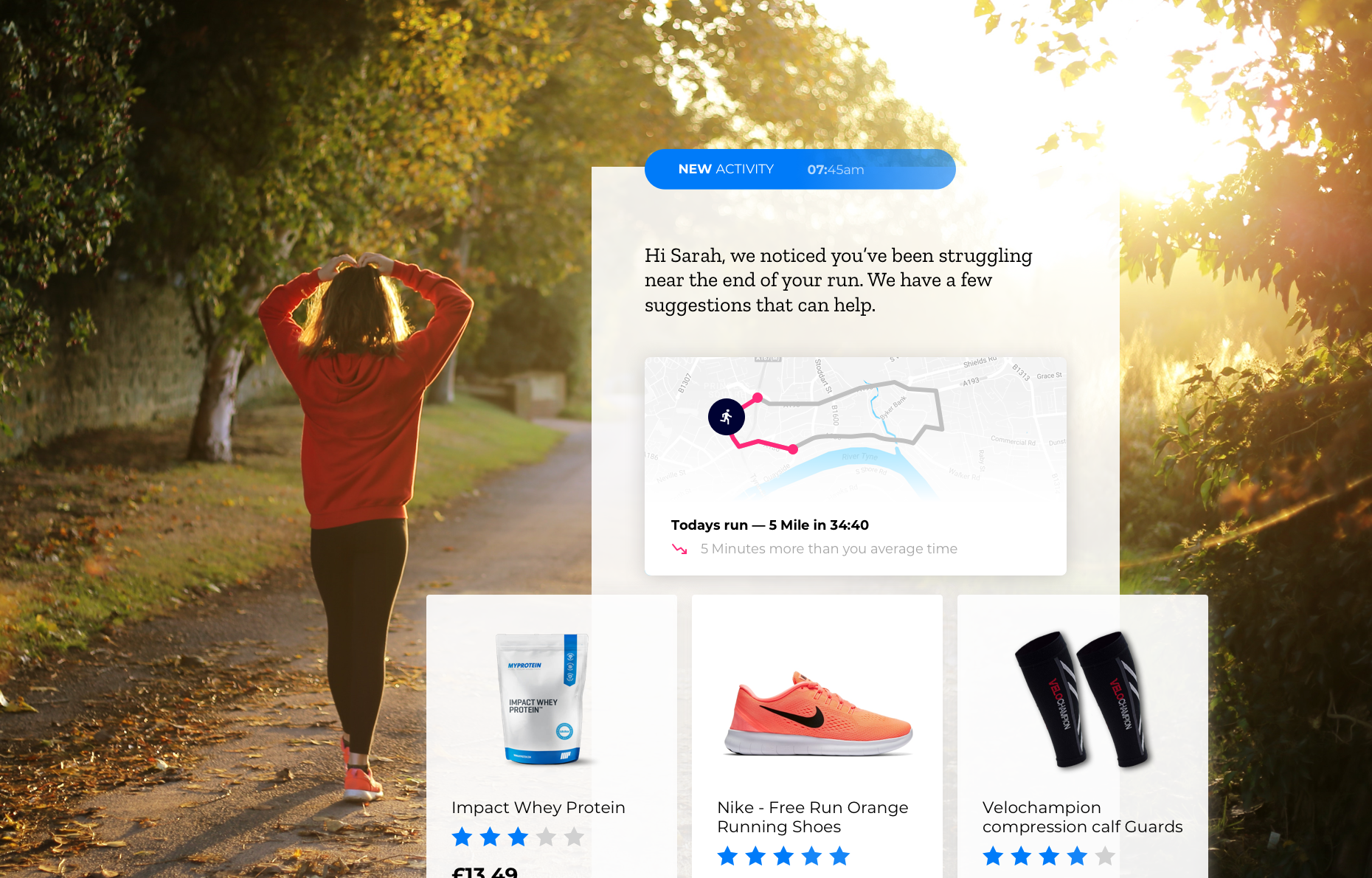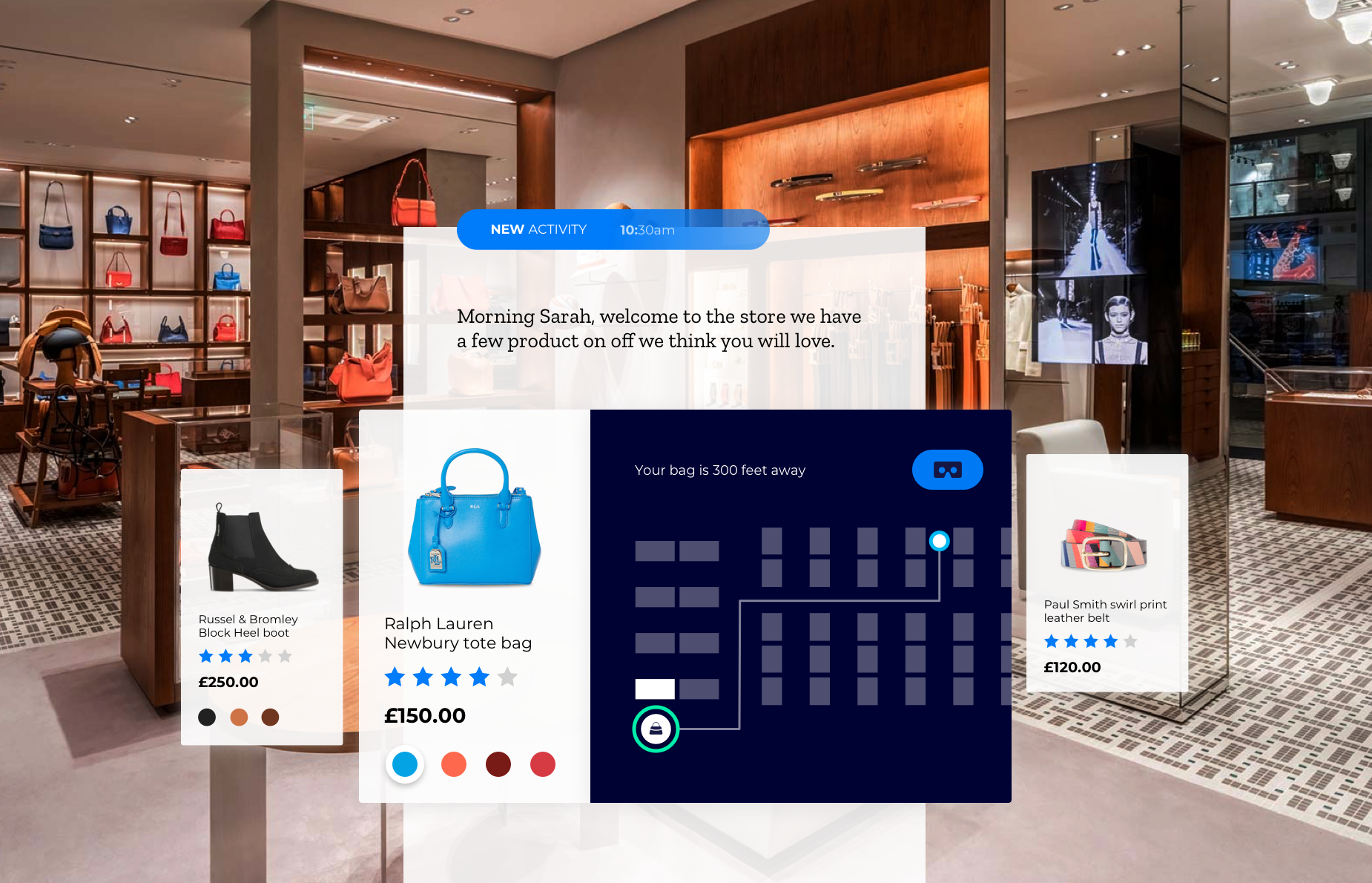
The next wave of digital
commerce aiCommerce.
The next wave of digital
commerce aiCommerce.
The next wave of digital
commerce aiCommerce.
The next wave of digital
commerce aiCommerce.
The next wave of digital
commerce aiCommerce.
This study looks to explore the potential of AI in retail and develop concepts that harness the power of AI.
AI is beginning to embed itself into all aspects of our lives, from the growing number of self-checkout cash registers to advanced security checks at the airport; artificial intelligence is just about everywhere.
With the current status of the online marketplace, e-commerce has become more saturated and competitive, for a business to succeed it needs to be faster, smarter and adaptive to their customers needs.
aiCommerce allows retailers to get closer to their customers by creating more meaningful experiences, instead of spending hours guessing how to target content for select demographics, retailers can now harness every single customer interaction to personalise the shopping experience.
This study looks to explore the potential of AI in retail and develop concepts that harness the power of AI.
AI is beginning to embed itself into all aspects of our lives, from the growing number of self-checkout cash registers to advanced security checks at the airport; artificial intelligence is just about everywhere.
With the current status of the online marketplace, e-commerce has become more saturated and competitive, for a business to succeed it needs to be faster, smarter and adaptive to their customers needs.
aiCommerce allows retailers to get closer to their customers by creating more meaningful experiences, instead of spending hours guessing how to target content for select demographics, retailers can now harness every single customer interaction to personalise the shopping experience.
This study looks to explore the potential of AI in retail and develop concepts that harness the power of AI.
AI is beginning to embed itself into all aspects of our lives, from the growing number of self-checkout cash registers to advanced security checks at the airport; artificial intelligence is just about everywhere.
With the current status of the online marketplace, e-commerce has become more saturated and competitive, for a business to succeed it needs to be faster, smarter and adaptive to their customers needs.
aiCommerce allows retailers to get closer to their customers by creating more meaningful experiences, instead of spending hours guessing how to target content for select demographics, retailers can now harness every single customer interaction to personalise the shopping experience.
This study looks to explore the potential of AI in retail and develop concepts that harness the power of AI.
AI is beginning to embed itself into all aspects of our lives, from the growing number of self-checkout cash registers to advanced security checks at the airport; artificial intelligence is just about everywhere.
With the current status of the online marketplace, e-commerce has become more saturated and competitive, for a business to succeed it needs to be faster, smarter and adaptive to their customers needs.
aiCommerce allows retailers to get closer to their customers by creating more meaningful experiences, instead of spending hours guessing how to target content for select demographics, retailers can now harness every single customer interaction to personalise the shopping experience.

Why is it the future?
Why is it the future?
Why is it the future?
Why is it the future?
Personalisation! aiCommerce can take content personalisation to the next level by rapidly analysing vast amounts of data. aiCommerce can identify patterns, recommend products and offers that are uniquely tailored to each customer.
This level of personalisation heightens the customer experience beyond measure, in turn helping retailers increase sales and brand loyalty.
Personalisation! aiCommerce can take content personalisation to the next level by rapidly analysing vast amounts of data. aiCommerce can identify patterns, recommend products and offers that are uniquely tailored to each customer.
This level of personalisation heightens the customer experience beyond measure, in turn helping retailers increase sales and brand loyalty.
Personalisation! aiCommerce can take content personalisation to the next level by rapidly analysing vast amounts of data. aiCommerce can identify patterns, recommend products and offers that are uniquely tailored to each customer.
This level of personalisation heightens the customer experience beyond measure, in turn helping retailers increase sales and brand loyalty.
Personalisation! aiCommerce can take content personalisation to the next level by rapidly analysing vast amounts of data. aiCommerce can identify patterns, recommend products and offers that are uniquely tailored to each customer.
This level of personalisation heightens the customer experience beyond measure, in turn helping retailers increase sales and brand loyalty.

By 2021, brands that support visual and voice based search will increase their digital commerce revenue by 30%
By 2021, brands that support visual and voice based search will increase their digital commerce revenue by 30%
By 2021, brands that support visual and voice based search will increase their digital commerce revenue by 30%
By 2021, brands that support visual and voice based search will increase their digital commerce revenue by 30%

IDC calculates that AI associated with CRM activities will boost global business revenue to £1Trillion by the end of 2021.
IDC calculates that AI associated with CRM activities will boost global business revenue to £1Trillion by the end of 2021.
IDC calculates that AI associated with CRM activities will boost global business revenue to £1Trillion by the end of 2021.
IDC calculates that AI associated with CRM activities will boost global business revenue to £1Trillion by the end of 2021.

By 2020 85% of a customers relationship with a business will be managed without interaction with a human.
By 2020 85% of a customers relationship with a business will be managed without interaction with a human.
By 2020 85% of a customers relationship with a business will be managed without interaction with a human.
By 2020 85% of a customers relationship with a business will be managed without interaction with a human.

Chatbots Will Account for $8Billion in Annual Savings by 2022
Chatbots Will Account for $8Billion in Annual Savings by 2022
Chatbots Will Account for $8Billion in Annual Savings by 2022
Chatbots Will Account for $8Billion in Annual Savings by 2022


Types of AI that will
impact commerce
Types of AI that will
impact commerce
Types of AI that will
impact commerce

Machine learning (ML) -powered shopping allows retailers to understand exactly the type of shopper who are engaging with their brand. Those insights allow for more tailored decisions on everything from merchandise assortment, marketing campaigns, to store design and buildout, as well as customer loyalty programs.
Machine learning (ML) -powered shopping allows retailers to understand exactly the type of shopper who are engaging with their brand. Those insights allow for more tailored decisions on everything from merchandise assortment, marketing campaigns, to store design and buildout, as well as customer loyalty programs.
Machine learning (ML) -powered shopping allows retailers to understand exactly the type of shopper who are engaging with their brand. Those insights allow for more tailored decisions on everything from merchandise assortment, marketing campaigns, to store design and buildout, as well as customer loyalty programs.
Machine learning (ML) -powered shopping allows retailers to understand exactly the type of shopper who are engaging with their brand. Those insights allow for more tailored decisions on everything from merchandise assortment, marketing campaigns, to store design and buildout, as well as customer loyalty programs.

Customer-centric search termed as ‘artificial intelligence with a vision’, empowers businesses to develop a personalised experience through advanced image and video recognition. This allows shoppers to discover complementary products based on size, colour, shape, fabric or even brand.
Customer-centric search termed as ‘artificial intelligence with a vision’, empowers businesses to develop a personalised experience through advanced image and video recognition. This allows shoppers to discover complementary products based on size, colour, shape, fabric or even brand.
Customer-centric search termed as ‘artificial intelligence with a vision’, empowers businesses to develop a personalised experience through advanced image and video recognition. This allows shoppers to discover complementary products based on size, colour, shape, fabric or even brand.
Customer-centric search termed as ‘artificial intelligence with a vision’, empowers businesses to develop a personalised experience through advanced image and video recognition. This allows shoppers to discover complementary products based on size, colour, shape, fabric or even brand.
Customer-centric search termed as ‘artificial intelligence with a vision’, empowers businesses to develop a personalised experience through advanced image and video recognition. This allows shoppers to discover complementary products based on size, colour, shape, fabric or even brand.

Facial and Image recognition can be used to capture customer dwell times in the physical store.
This means that if a customer spends a notable amount of time next to a specific product, then this information will be stored for use upon their next visit or digital experience with the brand.
Facial and Image recognition can be used to capture customer dwell times in the physical store.
This means that if a customer spends a notable amount of time next to a specific product, then this information will be stored for use upon their next visit or digital experience with the brand.
Facial and Image recognition can be used to capture customer dwell times in the physical store.
This means that if a customer spends a notable amount of time next to a specific product, then this information will be stored for use upon their next visit or digital experience with the brand.
Facial and Image recognition can be used to capture customer dwell times in the physical store.
This means that if a customer spends a notable amount of time next to a specific product, then this information will be stored for use upon their next visit or digital experience with the brand.

Chat bots can actively take on some of the important responsibilities that come with running an business, particularly when it comes to executing tasks for operations and marketing. Chatbots can automate order processes and are an effective and low-cost way of providing customer service.
Chat bots can actively take on some of the important responsibilities that come with running an business, particularly when it comes to executing tasks for operations and marketing. Chatbots can automate order processes and are an effective and low-cost way of providing customer service.
Chat bots can actively take on some of the important responsibilities that come with running an business, particularly when it comes to executing tasks for operations and marketing. Chatbots can automate order processes and are an effective and low-cost way of providing customer service.
Chat bots can actively take on some of the important responsibilities that come with running an business, particularly when it comes to executing tasks for operations and marketing. Chatbots can automate order processes and are an effective and low-cost way of providing customer service.

Hassle free shopping
Hassle free shopping

Scenario -----
Scenario -----
Scenario -----
Sarah wakes up and is going about her morning routine when she receives a notification from her local store “her order for the week has created and is ready for delivery.” The store has added items to the order based on her events for the week, recommendations from friends and products she regularly orders. Sarah then confirms the order and delivery date.
Sarah wakes up and is going about her morning routine when she receives a notification from her local store “her order for the week has created and is ready for delivery.” The store has added items to the order based on her events for the week, recommendations from friends and products she regularly orders. Sarah then confirms the order and delivery date.
Sarah wakes up and is going about her morning routine when she receives a notification from her local store “her order for the week has created and is ready for delivery.” The store has added items to the order based on her events for the week, recommendations from friends and products she regularly orders. Sarah then confirms the order and delivery date.
Sarah wakes up and is going about her morning routine when she receives a notification from her local store “her order for the week has created and is ready for delivery.” The store has added items to the order based on her events for the week, recommendations from friends and products she regularly orders. Sarah then confirms the order and delivery date.
One of the most enticing factors about online shopping, is it alleviates the need to wait in long lines or search from store to store for a particular item but doing this for the weekly shop can become a chore.
Customers regularly order the same products over and over again as part of their weekly shop, AI and ML can learn from a customers ordering habits and assist in creating a pre-populated shopping list.
One of the most enticing factors about online shopping, is it alleviates the need to wait in long lines or search from store to store for a particular item but doing this for the weekly shop can become a chore.
Customers regularly order the same products over and over again as part of their weekly shop, AI and ML can learn from a customers ordering habits and assist in creating a pre-populated shopping list.
One of the most enticing factors about online shopping, is it alleviates the need to wait in long lines or search from store to store for a particular item but doing this for the weekly shop can become a chore.
Customers regularly order the same products over and over again as part of their weekly shop, AI and ML can learn from a customers ordering habits and assist in creating a pre-populated shopping list.
One of the most enticing factors about online shopping, is it alleviates the need to wait in long lines or search from store to store for a particular item but doing this for the weekly shop can become a chore.
Customers regularly order the same products over and over again as part of their weekly shop, AI and ML can learn from a customers ordering habits and assist in creating a pre-populated shopping list.
By pre-populating orders based on customer behaviours, buying habits and data sources such as calendars and social media retailers can create a tailored shopping experience for their customers.
This saves the customer time, builds brand loyalty and gives retailers a direct line into the home of their customers allowing them up-sell personalised products straight to the customer.
By pre-populating orders based on customer behaviours, buying habits and data sources such as calendars and social media retailers can create a tailored shopping experience for their customers.
This saves the customer time, builds brand loyalty and gives retailers a direct line into the home of their customers allowing them up-sell personalised products straight to the customer.
By pre-populating orders based on customer behaviours, buying habits and data sources such as calendars and social media retailers can create a tailored shopping experience for their customers.
This saves the customer time, builds brand loyalty and gives retailers a direct line into the home of their customers allowing them up-sell personalised products straight to the customer.
By pre-populating orders based on customer behaviours, buying habits and data sources such as calendars and social media retailers can create a tailored shopping experience for their customers.
This saves the customer time, builds brand loyalty and gives retailers a direct line into the home of their customers allowing them up-sell personalised products straight to the customer.
Universal customer experience
Universal customer experience

Scenario -----
Scenario -----
Scenario -----
Out on her morning run her smart watch records that Sarah struggled in the last 1/2 mile and has been struggling for a few weeks. Sarah then recieves product recomendations and services that will help with her daily workout.
Out on her morning run her smart watch records that Sarah struggled in the last 1/2 mile and has been struggling for a few weeks. Sarah then recieves product recomendations and services that will help with her daily workout.
Out on her morning run her smart watch records that Sarah struggled in the last 1/2 mile and has been struggling for a few weeks. Sarah then recieves product recomendations and services that will help with her daily workout
Out on her morning run her smart watch records that Sarah struggled in the last 1/2 mile and has been struggling for a few weeks. Sarah then recieves product recomendations and services that will help with her daily workout.
Retailers no longer have to rely on the traditional ways customers engage with their brand and products, aiCommerce will allow retailers to analyise huge data sets form multiple sources to define the best products for their customers.
New AI engines, such as Boomtrain and IBM’s Watson, sit on top of the multiple customer touch points to help the business analyse how customers are interacting online.
Retailers no longer have to rely on the traditional ways customers engage with their brand and products, aiCommerce will allow retailers to analyise huge data sets form multiple sources to define the best products for their customers.
New AI engines, such as Boomtrain and IBM’s Watson, sit on top of the multiple customer touch points to help the business analyse how customers are interacting online.
Retailers no longer have to rely on the traditional ways customers engage with their brand and products, aiCommerce will allow retailers to analyise huge data sets form multiple sources to define the best products for their customers.
New AI engines, such as Boomtrain and IBM’s Watson, sit on top of the multiple customer touch points to help the business analyse how customers are interacting online.
Retailers no longer have to rely on the traditional ways customers engage with their brand and products, aiCommerce will allow retailers to analyise huge data sets form multiple sources to define the best products for their customers.
New AI engines, such as Boomtrain and IBM’s Watson, sit on top of the multiple customer touch points to help the business analyse how customers are interacting online.
Whether it is a mobile application, website, or an email campaign, the AI engine is continuously monitoring all devices and channels to create a universal customer view.
This enables retailers to deliver a seamless customer experience across all platforms.
Whether it is a mobile application, website, or an email campaign, the AI engine is continuously monitoring all devices and channels to create a universal customer view.
This enables retailers to deliver a seamless customer experience across all platforms.
Whether it is a mobile application, website, or an email campaign, the AI engine is continuously monitoring all devices and channels to create a universal customer view.
This enables retailers to deliver a seamless customer experience across all platforms.
Whether it is a mobile application, website, or an email campaign, the AI engine is continuously monitoring all devices and channels to create a universal customer view.
This enables retailers to deliver a seamless customer experience across all platforms.

Natural language
Natural language

Scenario -----
Scenario -----
Scenario -----
Sarah’s looking for a family holiday to Florida. While she's out for lunch, she does a quick search for “family holiday to florida in june”. Her search returns results tailored to her and her family.
Sarah’s looking for a family holiday to Florida. While she's out for lunch, she does a quick search for “family holiday to florida in june”. Her search returns results tailored to her and her family.
Sarah’s looking for a family holiday to Florida. While she's out for lunch, she does a quick search for “family holiday to florida in june”. Her search returns results tailored to her and her family.
Sarah’s looking for a family holiday to Florida. While she's out for lunch, she does a quick search for “family holiday to florida in june”. Her search returns results tailored to her and her family.
This may sound like a straight forward scenario but customers often abandon
e-commerce experiences because the product results displayed from a search are often irrelevant.
aiCommerce can utilise natural language processing to narrow, contextualise and improve search results for online shoppers.
This may sound like a straight forward scenario but customers often abandon
e-commerce experiences because the product results displayed from a search are often irrelevant.
aiCommerce can utilise natural language processing to narrow, contextualise and improve search results for online shoppers.
This may sound like a straight forward scenario but customers often abandon
e-commerce experiences because the product results displayed from a search are often irrelevant.
aiCommerce can utilise natural language processing to narrow, contextualise and improve search results for online shoppers.
This may sound like a straight forward scenario but customers often abandon
e-commerce experiences because the product results displayed from a search are often irrelevant.
aiCommerce can utilise natural language processing to narrow, contextualise and improve search results for online shoppers.
This is how Sarah’s search would be broken down to give her a better experience.
Family: Through previous interactions we know she has 2 children, a husband and a dog.
Holiday: Narrows down the category search.
Florida: Destination to suggest modes of transport.
June: Timeframe that aligns with the family calendar.
This is how Sarah’s search would be broken down to give her a better experience.
Family: Through previous interactions we know she has 2 children, a husband and a dog.
Holiday: Narrows down the category search.
Florida: Destination to suggest modes of transport.
June: Timeframe that aligns with the family calendar.
This is how Sarah’s search would be broken down to give her a better experience.
Family: Through previous interactions we know she has 2 children, a husband and a dog.
Holiday: Narrows down the category search.
Florida: Destination to suggest modes of transport.
June: Timeframe that aligns with the family calendar.
This is how Sarah’s search would be broken down to give her a better experience.
Family: Through previous interactions we know she has 2 children, a husband and a dog.
Holiday: Narrows down the category search.
Florida: Destination to suggest modes of transport.
June: Timeframe that aligns with the family calendar.
Hyper-personalisation
Hyper-personalisation
Hyper-personalisation

Scenario -----
Scenario -----
Scenario -----
On the train home Sarah gets a notification to tell her that those boots she loved are on offer, shes happy and makes the purchase on her phone, saving a lot of steps for both the retailer and Sarah.
On the train home Sarah gets a notification to tell her that those boots she loved are on offer, shes happy and makes the purchase on her phone, saving a lot of steps for both the retailer and Sarah.
On the train home Sarah gets a notification to tell her that those boots she loved are on offer, shes happy and makes the purchase on her phone, saving a lot of steps for both the retailer and Sarah.
On the train home Sarah gets a notification to tell her that those boots she loved are on offer, shes happy and makes the purchase on her phone, saving a lot of steps for both the retailer and Sarah.
Facial recognition is already being used to capture shoplifters by scanning their faces on CCTV cameras, it not a huge leap to leverage this technology to qualify potential buyers for your product.
Facial recognition can monitor how retail customers are spending their time in store, for example if a customer spends a notable amount of time next to a specific product, this information will be stored to build up their profile and notify them when there is an offer on that product.
Facial recognition is already being used to capture shoplifters by scanning their faces on CCTV cameras, it not a huge leap to leverage this technology to qualify potential buyers for your product.
Facial recognition can monitor how retail customers are spending their time in store, for example if a customer spends a notable amount of time next to a specific product, this information will be stored to build up their profile and notify them when there is an offer on that product.
Facial recognition is already being used to capture shoplifters by scanning their faces on CCTV cameras, it not a huge leap to leverage this technology to qualify potential buyers for your product.
Facial recognition can monitor how retail customers are spending their time in store, for example if a customer spends a notable amount of time next to a specific product, this information will be stored to build up their profile and notify them when there is an offer on that product.
Facial recognition is already being used to capture shoplifters by scanning their faces on CCTV cameras, it not a huge leap to leverage this technology to qualify potential buyers for your product.
Facial recognition can monitor how retail customers are spending their time in store, for example if a customer spends a notable amount of time next to a specific product, this information will be stored to build up their profile and notify them when there is an offer on that product.
We can apply that same logic to break down the scenario and explain how those boots were recommended to Sarah.
2 weeks ago Sarah was in her a highstreet store looking at a pair of boots, the store was measuring her vitals through her wearable, her pupil dilation and her dwell time we monitored by in-store cameras to track her engagement with the product.
These factors indicatored Sarah was intersted in the product and once there was an offer available, Sarah was notified.
We can apply that same logic to break down the scenario and explain how those boots were recommended to Sarah.
2 weeks ago Sarah was in her a highstreet store looking at a pair of boots, the store was measuring her vitals through her wearable, her pupil dilation and her dwell time we monitored by in-store cameras to track her engagement with the product.
These factors indicatored Sarah was intersted in the product and once there was an offer available, Sarah was notified.
We can apply that same logic to break down the scenario and explain how those boots were recommended to Sarah.
2 weeks ago Sarah was in her a highstreet store looking at a pair of boots, the store was measuring her vitals through her wearable, her pupil dilation and her dwell time we monitored by in-store cameras to track her engagement with the product.
These factors indicatored Sarah was intersted in the product and once there was an offer available, Sarah was notified.
We can apply that same logic to break down the scenario and explain how those boots were recommended to Sarah.
2 weeks ago Sarah was in her a highstreet store looking at a pair of boots, the store was measuring her vitals through her wearable, her pupil dilation and her dwell time we monitored by in-store cameras to track her engagement with the product.
These factors indicatored Sarah was intersted in the product and once there was an offer available, Sarah was notified.
Virtual assistants
Virtual assistants

Scenario -----
Scenario -----
Scenario -----
Sarah is shopping with her family, she walks into a store and is greeted by a digital assistant on her phone, it which recomends products based on her buying habbits.
She chooses a product and the assistant directs her to the products location in store.
Sarah is shopping with her family, she walks into a store and is greeted by a digital assistant on her phone, it which recomends products based on her buying habbits.
She chooses a product and the assistant directs her to the products location in store.
Sarah is shopping with her family, she walks into a store and is greeted by a digital assistant on her phone, it which recomends products based on her buying habbits. She chooses a product and the assistant directs her to the products location in store.
Sarah is shopping with her family, she walks into a store and is greeted by a digital assistant on her phone, it which recomends products based on her buying habbits.
She chooses a product and the assistant directs her to the products location in store.
Many e-commerce retailers are already becoming more sophisticated with their AI capabilities in capturing customer attention, one approach that is gaining traction is known as ‘conversational commerce’. this is the confluence of visual, vocal, written and predictive capabilities know as a chatbot.
Chatbots can take on some of the important responsibilities that come with managing retail businesses, they can automate order processes and are an effective and low-cost way of providing good customer service.
Many e-commerce retailers are already becoming more sophisticated with their AI capabilities in capturing customer attention, one approach that is gaining traction is known as ‘conversational commerce’. this is the confluence of visual, vocal, written and predictive capabilities know as a chatbot.
Chatbots can take on some of the important responsibilities that come with managing retail businesses, they can automate order processes and are an effective and low-cost way of providing good customer service.
Many e-commerce retailers are already becoming more sophisticated with their AI capabilities in capturing customer attention, one approach that is gaining traction is known as ‘conversational commerce’. this is the confluence of visual, vocal, written and predictive capabilities know as a chatbot.
Chatbots can take on some of the important responsibilities that come with managing retail businesses, they can automate order processes and are an effective and low-cost way of providing good customer service.
Can chatbots replace the need to engage with a human altogether? Probably not but they can go a long way to providing a seamless customer experience across all key touch points of the brand.
Can chatbots replace the need to engage with a human altogether? Probably not but they can go a long way to providing a seamless customer experience across all key touch points of the brand.
Can chatbots replace the need to engage with a human altogether? Probably not but they can go a long way to providing a seamless customer experience across all key touch points of the brand.
Can chatbots replace the need to engage with a human altogether? Probably not but they can go a long way to providing a seamless customer experience across all key touch points of the brand.
What is the future
for aiCommerce?
What is the future
for aiCommerce?
What is the future
for aiCommerce?
As more online retailers recognise the benefits that AI technology offers, we will continue to see existing innovations improve, andmore excitingly, new developments that will emerge to furthertransform the future of e-commerce.
We can predict aiCommerce will be used to create multi-layer data on every customer, based on their past and current buying behaviour,that builds an ever improving prediction of future needs. But willthis level of personalisation be too intrusive for customers?
Time will tell but we believe that it’s our responsibility to make sure AI and cognitive learning are tools that are un-intrusive and assistcustomer needs. They should always put the customer at the centre of what the technology will do and ultimately help customers master the retail environment, in order to make their lives that little bitbetter.
As more online retailers recognise the benefits that AI technology offers, we will continue to see existing innovations improve, andmore excitingly, new developments that will emerge to furthertransform the future of e-commerce.
We can predict aiCommerce will be used to create multi-layer data on every customer, based on their past and current buying behaviour,that builds an ever improving prediction of future needs. But willthis level of personalisation be too intrusive for customers?
Time will tell but we believe that it’s our responsibility to make sure AI and cognitive learning are tools that are un-intrusive and assistcustomer needs. They should always put the customer at the centre of what the technology will do and ultimately help customers master the retail environment, in order to make their lives that little bitbetter.
As more online retailers recognise the benefits that AI technology offers, we will continue to see existing innovations improve, andmore excitingly, new developments that will emerge to furthertransform the future of e-commerce.
We can predict aiCommerce will be used to create multi-layer data on every customer, based on their past and current buying behaviour,that builds an ever improving prediction of future needs. But willthis level of personalisation be too intrusive for customers?
Time will tell but we believe that it’s our responsibility to make sure AI and cognitive learning are tools that are un-intrusive and assistcustomer needs. They should always put the customer at the centre of what the technology will do and ultimately help customers master the retail environment, in order to make their lives that little bitbetter.
As more online retailers recognise the benefits that AI technology offers, we will continue to see existing innovations improve, andmore excitingly, new developments that will emerge to furthertransform the future of e-commerce.
We can predict aiCommerce will be used to create multi-layer data on every customer, based on their past and current buying behaviour,that builds an ever improving prediction of future needs. But willthis level of personalisation be too intrusive for customers?
Time will tell but we believe that it’s our responsibility to make sure AI and cognitive learning are tools that are un-intrusive and assistcustomer needs. They should always put the customer at the centre of what the technology will do and ultimately help customers master the retail environment, in order to make their lives that little bitbetter.
